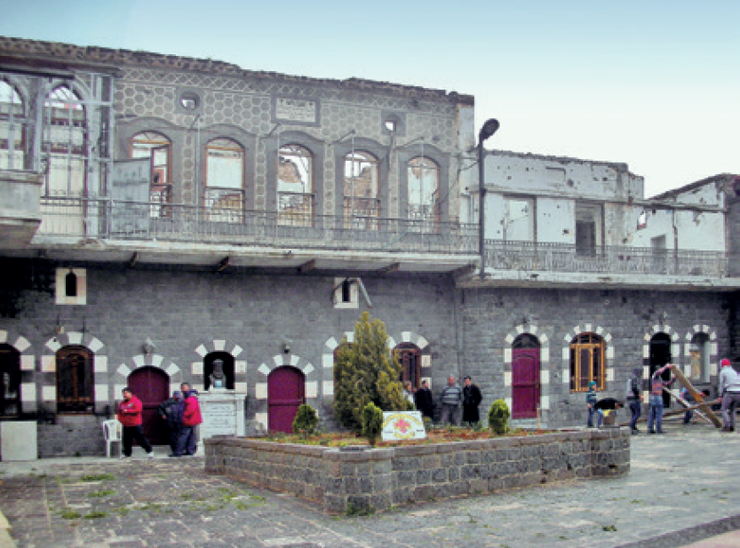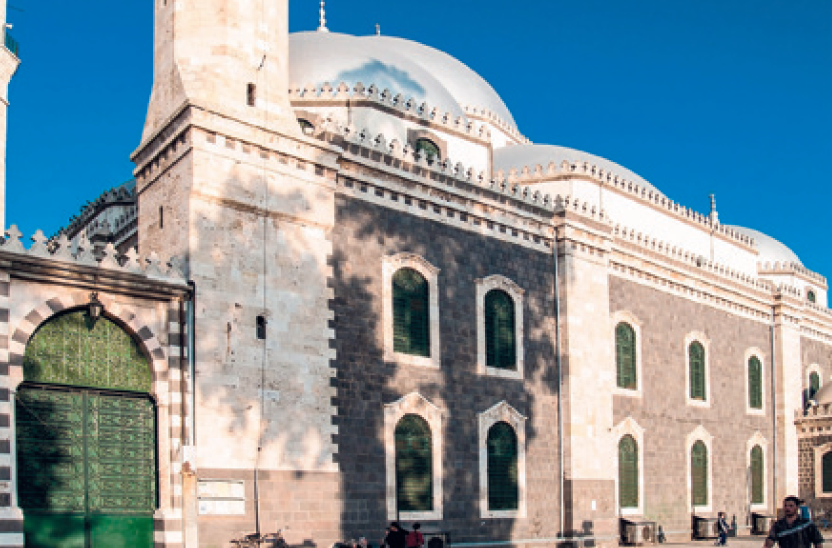Rebuilding and reconciliation in Homs
With the fighting seeming to be over in the Syrian city of Homs, the reconstruction of damaged religious buildings has given impetus to rebuilding the city’s communities.

|

|
| The courtyard of St Mary’s Church and its extension n 2015 after the ground floor had been reconstructed (Photo: Ataa Alsalloum). | Khalid ibn al-Walid Mosque (right and below) before the civil war (Photo: Wikipedia). |
The Syrian government has reclaimed control of Homs. Most opposition fighters had already left the city in 2014, after two years of fighting which had resulted in massive destruction of its historic fabric.
The Unesco world heritage centre notes that Syria has six cultural heritage sites and another 12 on the tentative list. The country’s heritage stretches way beyond the world heritage status, and has several contributions to the modern life of humanity. For example, the first set of alphabet letters and music notes in the world, dated 1400BC, come from Ugarit and Ebla in North Syria. The list of heritage categories in Syria is extensive, including, but not limited to, natural heritage, cultural routes, movable properties and intangible heritage. The six Unesco sites were moved to the in-danger list in 2013 because of the destruction and threats to their outstanding universal value.
Homs was once Syria’s third-largest populated city after Aleppo and Damascus. Its communities (mainly Christians and Muslims), supported by local authorities, took the initial step towards post-war reconciliation, despite the continued conflict. This has been led by the reconstruction of two important historic religious buildings: St Mary’s Church of the Holy Belt (Um az-Zinnar, as pronounced in Arabic) and Khalid ibn al-Walid Mosque. This work shows that, despite the devastating destruction and the erosion of the unique sense of place, significant historic religious buildings can contribute to post-war reconciliation.
The old city of Homs includes exemplar historical properties from the various civilizations which have inhabited it through the ages. An example is the citadel, dating back to the third millennium BC, which was renovated during Roman times and through the Islamic era. Several types of historical monument, including traditional markets and courtyard houses, occupy the old city. Homs is famous for its historical architectural style with alternating rows of light and dark masonry, for which it is fondly known as the City of Black Stones. However, a major urban renewal project in the old city in the 1980s resulted in the destruction of a number of significant monuments.
One of the present authors, Ataa Alsalloum, was born in Homs and spent her childhood there. Visits to the the old covered souks was great fun, providing a place for community, bartering and exchange. In her neighbourhood of Al Hamidia, visiting the three iconic churches (Greek Roman of Forty Martyrs, Greek Catholic and St Mary) on Palm Sunday with a group of friends was one of the best memories, including going from one church to another after mass to see the celebrations outside the churches, and to collect the special brooches issued on that day. St Mary’s Church was one of Alsalloum’s favourite places because of its location among other churches and its accomplished choir, accompanied by percussion. In Homs, Greek, Catholic and Anglican denominations live together with no differences. Christians make up 10 per cent of Syria’s population.
St Mary’s Church is a historical Syriac Orthodox Church, where the Sunday mass used to be in the Syriac/ Aramaic language. Built over an underground church dating back to 50AD, it is claimed to house the belt of the Virgin Mary, after whom the church is named. It was rebuilt in 1852 as an extension for the very old church, with the local black basalt stones of Homs and a simple cruciform plan. The church was built by local skilled builders from Al Hamidia district. It is the seat of the Syriac Orthodox archbishopric in Syria.
Before the armed conflict, the church used to play a vital role in the community. It taught the Syriac/Aramaic language and provided a parish hall, youth clubs, music groups, choirs and brass bands. It was severely damaged in 2012. The opposition forces used it as a shelter and destroyed all signs of Christianity in it. Fortunately, the holy belt had been removed and was saved.
In 2015, when fighting in several parts of Homs, including in Al Hamidia district, died down, a few families returned to the neighbourhood to check their houses and other properties. The restoration work was started in the church of St Mary with extensive efforts by local community volunteers and local skilled workers. Some of the workers were the descendants of the builders of 1852. The work started from the inside, by supporting the old pillars and vaults, then turned to the roofs and finally the facades. The remains of the previous black stones were used in addition to available building materials such as bricks. An extension to the church was built to accommodate a number of young priests who supervised the work.
When the reconstruction work was finished, several families were encouraged to come back and restore their houses. A young couple from the local community celebrated their wedding in the church as a sign of returning home. Palm Sunday and Easter prayers were fully celebrated in 2017. Several facilities, including shops, pharmacy and a cafe, have been operated in Al Hamidia by the locals, and the restoration of the church inspired the restoration of the other churches in the neighbourhood.
Al Hamidia shares borders with Al Khalidia district to the north. This district is named after the Khalid ibn al-Walid mosque, which is the symbol of Homs city on signposts. The mosque is dedicated to the Arab Muslim leader, Khalid ibn al-Walid. The mausoleum of ibn al-Walid is believed to be topped by the mosque’s main dome. There are two tall minarets at the north-western and north-eastern corners, constructed of the traditional alternating horizontal rows of white-and-black stone. As the building was constructed during the Ottoman occupation, it has Ottoman Islamic architectural characters and a large courtyard. The building has one dominant dome with nine smaller domes. The walls, like those of St Mary’s, are of basalt.
The mosque suffered in the conflict and reconstruction was started in 2015. Because of complications in the construction of the dome, the renovation took longer than the repair of the church. The same local skilled workers participated in the reconstruction, along with local conservation experts. The process encouraged a few Muslim families to reconstruct their houses.
The restoration of these two historic religious buildings has been a catalyst for the reoccupation and rebuilding of residential districts. This small step provided sufficient inspiration to take the difficult move towards post-conflict reconciliation.
The memory, identity, historic and religious values attributed to the two buildings is helping to put a new heart into the communities. The support of the local authorities has helped to rebuild trust. Homs should be an example for other cities in Syria of how restoring structures can lead to reforming communities
This article originally appeared in IHBC’s Context 150, published in July 2017. It was written by Ataa Alsalloum and Iain Jackson. Ataa Alsalloum, formerly a lecturer at Damascus University, is a research associate at the University of Liverpool school of architecture. Iain Jackson is a professor and architect at the University of Liverpool school of architecture.
--Institute of Historic Building Conservation
Find out more
Related articles on Designing Buildings Wiki
IHBC NewsBlog
Old Sarum fire in listed (& disputed) WW1 Hangar - Wiltshire Council has sought legal advice after fire engulfed a listed First World War hangar that was embroiled in a lengthy planning dispute.
UK Antarctic Heritage Trust launches ‘Virtual Visit’ website area
The Trust calls on people to 'Immerse yourself in our heritage – Making Antarctica Accessible'
Southend Council pledge to force Kursaal owners to maintain building
The Council has pledged to use ‘every tool in the toolbox’ if urgent repairs are not carried out.
HE’s Research Magazine publishes a major study of the heritage of England’s suburbs
The article traces the long evolution of an internal programme to research 200 years of suburban growth
IHBC Context 183 Wellbeing and Heritage published
The issue explores issues at the intersection of heritage and wellbeing.
SAVE celebrates 50 years of campaigning 1975-2025
SAVE Britain’s Heritage has announced events across the country to celebrate bringing new life to remarkable buildings.
IHBC Annual School 2025 - Shrewsbury 12-14 June
Themed Heritage in Context – Value: Plan: Change, join in-person or online.
200th Anniversary Celebration of the Modern Railway Planned
The Stockton & Darlington Railway opened on September 27, 1825.
Competence Framework Launched for Sustainability in the Built Environment
The Construction Industry Council (CIC) and the Edge have jointly published the framework.
Historic England Launches Wellbeing Strategy for Heritage
Whether through visiting, volunteering, learning or creative practice, engaging with heritage can strengthen confidence, resilience, hope and social connections.














